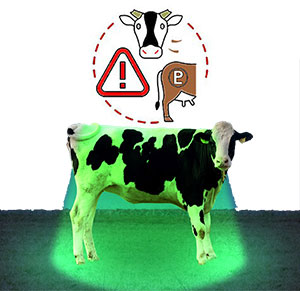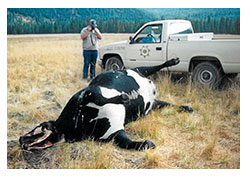Cattle mutilation (also known as bovine excision and unexplained livestock death, or animal mutilation) is the killing and mutilation of cattle under supposedly unusual, usually bloodless circumstances. This phenomenon has been observed among wild animals as well.
Worldwide, sheep, horses, goats, pigs, rabbits, cats, dogs, bison, moose, deer and elk have been reported mutilated with similar bloodless excisions; often an ear, eyeball, jaw flesh, tongue, lymph nodes, genitals and rectum are removed.
Mysterious cases of dead, mutilated cattle along a Texas highway has left local authorities puzzled.
"Each incident occurred in different locations, pastures, and herds," the sheriff's office wrote in a Facebook post on April 19. "Multiple similar incidents have been reported across the United States and we are actively coordinating with other agencies to find answers."
Read More >>>>
The 6-year-old cow was found dead lying on one side with a "straight, clean cut, with apparent precision," removing the hide around the exposed side of its mouth, according to the sheriff's office. The animal's "tongue was also completely removed," the sheriff's office said.
Five other cows -- four adults and a yearling -- were found in the same condition, except two also had circular cuts "made with the same precision" to remove additional external organs, according to the sheriff's office.
In all six cases, the sheriff's office said there were no blood spills or signs of struggle. The grass around the deceased animals was also undisturbed and there were no noticeable footprints or tire tracks in the area, authorities said. Neither predators nor birds scavenged the remains, leaving the bodies to "decay untouched for several weeks," according to the sheriff's office.
The cause of death of all six cows remains unknown and under investigation. The sheriff's office did not immediately respond to ABC News' request for comment on Monday.
Anyone with information on the cases or who observes any similar occurrences is asked to contact the Madison County Sheriff’s Office at 936-348-2755.
Cattle mutilations 1973-1980
Waves of cattle mutilations were reported in Kansas, Nebraska, Colorado, and New Mexico.
In April 1973, sheriffs in Western Iowa reported unidentified helicopters involved in cattle and pig rustling. In August, similar helicopter-based rustling were reported in Missouri and authorities warned farmers not to fire on helicopters.
1973 Kansas wave
On June 10, 1973, Cloud County sheriff Fred Modlin warned the public about a series of telephone calls from a caller identifying as a USDA official conducting a survey of herd population and locations. After the USDA denied such a survey, Modlin advised that the calls might be coming from rustlers.
On June 14, a 700-pound Heifer was found butchered on the Ray Vizner farm near Munden, Kansas. Its right ear had reported been removed and right rear quarter butchered; Republic County sheriff Bob Blecha argue the death was not the work of predators. Two weeks later, on June 18, a second butchered cow was found on the Lowell Darcy farm, twenty miles away from the first butchered cow; Like the first, its right ear was removed. Local press initially speculated about a 'Mad Dog' or 'phantom' Butcher.
On August 9, a third butchered cow was found, this one in South County.
On August 30, a fourth butchered cow was reported, this one on the Larry LeBlanc farm south of St. Joseph in Cloud County; The right ear was again removed.
On October 25, three cows in Harvey County were discovered with their sex organs removed. On November 15, press reported a slain cow on the Don Peter farm near Munden, the seventh animal death attributed to the "butcher". The November 22 issue of the Belleville Telescope again referenced the "Mad Dog Cattle Butcher".
Cattle Mutilations by county in Kansas and Nebraska, as of December 13, 1973.
On December 4, 1973, law enforcement including Modlin reported a wave of cattle deaths in seven counties across Kansas and Nebraska. Sexual organs were reported having been removed. An upcoming meeting on the mutilations was announced. On December 6, a killing on the Lavern Hiner farm in Cloud County was reported to be the butcher's ninth. By December 13, Kansas law enforcement reported having investigated a total of 40 mutilations, most occurring on land near US Highway 81. On December 20, State Senator Ross Doyen reported a cattle mutilation on his ranch.
On December 22, the Kansas Brand Commissioner's office determined that most of the deaths and removal of sex organs were the result of natural causes including predation, "shipping fever" and blackleg. Modlin and others vocally disagreed with these conclusions and denied that local ranchers would mutilate dead animals for insurance money, calling them "honest and respectable".
1974 Nebraska wave
Reports resumed in April 1974, when a Nebraska cow was discovered mutilated and drained of blood. That month, the North American Newspaper Alliance reported on the 1973 mutilations along with sightings of unidentified helicopters.
In May, two mutilations were reported in Mills County, Iowa; An AP story argued coyotes were responsible. By June 1974, mutilations were reported in Lancaster County, Nebraska. Custer Country reported similar helicopter sightings and armed patrols. On August 14, 1974, the Cascade County, Montana Sheriff's Office received its first report of a mutilated cow.
On August 20, press reported a "new twist" in the mutilations: Days prior, near Agnew, Nebraska, an unidentified helicopter had been spotted hovering 400 feet above where a mutilated cow would later be discovered. The helicopter was reported shining a spotlight into the field; FAA and National Guard reported no knowledge of helicopters operating in the area. Knox County Sheriff Herbert Thompson reported that armed civilians had begun patrols in response to repeated helicopter sightings. Cloud County Attorney William Walsh told press of a jailhouse informant who claimed to be a former cult member and opined the mutilations were likely the result of devil-worshiping cultists. The Kansas Bureau of Investigation and the Kansas Brand Inspectors were reported to lean toward predators as the cause. Amid the cattle mutilation jitters and drought, Oakland, Nebraska experienced as spate of "beast" sightings as residents feared an unidentified noisy night-time animal. State Sen. John Decamp called on authorities to coordinate an investigation into the mutilations. As on August 28, there had been 25 mutilations reported across five Nebraska counties.
On August 28, press reported that a rancher near Hartington had apparently thwarted a mutilation in progress when he found a helicopter above his field was spotted by a neighbor who summons the sheriff; All three reportedly witnessed the helicopter as well as a car that also seen shining a spotlight into the field. The following morning, a dead cow was found near where the helicopter had been spotted, but the cow had not been mutilated. Authorities cautioned the public not to shoot at aircraft. On September 5, it was reported that authorities had ordered helicopters to fly above 1000 feet after a commercial helicopter took two bullets during a power line inspection.
On September 11, a supposedly-mutilated cow was revealed at autopsy to have died of natural causes, i.e. bacterial infection. It was the third such mutilation disproved by authorities as the University of Nebraska's Department of Veterinary Science. On September 17, over 50 law enforcement officials from 24 counties attended a meeting at the Knox County Courthouse in Center, Nebraska to discuss the mutilations. Participants, who dismissed the cult theory, estimated that out of 80 cow deaths under discussion, about 27 were suspected mutilations.
On September 19, press reported three cases of alleged mutilations in South Dakota: Two in Moody County and one in Lake County. On the advice of the Sheriff, patrols were organized, and farmers were instructed to check their herds every 12 hours.
On September 30, papers reported on an unusual cow death where the animal was shot with a firearm, incised, and set aflame with fuel oil. Unlike other cases, removed body parts were left on site and no parts of the animal were taken.
In the September 30, 1974 issue of Newsweek, the magazine became the first national outlet to cover the ongoing mutilation story; Its story reported 100 cattle mutilated in Nebraska, Kansas, and Iowa since May.
On October 2, 1974, South Dakota Attorney General Kermit Sande told press that a number of mutilations had been reported in the state. Mutilations had been reported in three counties, and a psychiatrist argued the person responsible might be psychotic. After five mutilations were reported in Day County, a $500 reward was offered.
It was reported that UFO conspiracy theorists considered cattle mutilations might be related to flying saucers; On November 15, UFO expert J. Allen Hynek released a statement denying any link.
On December 2 1974, press reported on the Minnesota mutilations: two in Kandiyohi County, six in Swift County, and one in Meeker County. The Meeker animal was reportedly drained of blood.
Between 1970 and 1974, twenty-two mutilated cattle were reported in Minnesota.
1975 Colorado
The Snippy case occurred on the Harry King Ranch, located in Colorado's San Luis Valley near Alamosa.
In 1975, the Colorado Associated Press voted the mutilations as the state's top story. Senator Floyd K. Haskell contacted the FBI asking for help in 1975 due to public concern regarding the issue. He claimed there had been 130 mutilations in Colorado alone, and further reports across nine states.[63] A 1979 FBI report indicated that, according to investigations by the New Mexico State Police, there had been an estimated 8,000 mutilations in Colorado, causing approximately $1 million in damages.
In January 1975, the Michigan ATF tasked Donald E. Flickinger with investigating the mutilations; Flickinger investigated possible links to a "Hell-oriented biker gang". In May 1975, the Colorado Bureau of Investigation opened an investigation under the leadership of Carl Whiteside.
In October 1975, the New York Times published a story examining cattle mutilations across 11 states.
1976 Dulce, New Mexico
On June 13, 1976, Dulce rancher Manuel Gomez reported a mutilation to Officer Gabe Valdez of the New Mexico State Patrol.
1979 Public meeting
On April 20, 1979, U.S. Attorney R. E. Thompson and US Senator Harrison Schmidt held a public meeting about cattle mutilations. The meeting was attended by about 80 people. One attendee was Paul Bennewitz, who approached Valdez and reported having seen unidentified lights over Kirtland Air Force Base.
On May 2, 1979, Valdez told press that two drugs had been found in the remains of a mutilated bull found in Torrance County on February 15. Valdez reported one drug, Chlorpromazine (Thorazine), was used to tranquilize and immobilize the animal, while a second, unnamed drug was used to "clog the blood and remove it through the jugular vein." Valdez told papers "We know this stuff is made here, and it isn't from outer space. Whoever is doing it is highly sophisticated, and they have a lot of resources. They're well organized". Valdez was described as "the state's chief information source on mutilations, having worked on 32 cases... in about three years".
On June 14, 1981, investigators found a mutilated cow at the Gomez ranch with a large amount of radar chaff nearby.





 The Madison County Sheriff's Office said last week that its deputies were investigating the death of a 6-year-old longhorn-cross cow on a ranch when "five other similar occurrences" were reported along the area of Texas State Highway OSR, near the eastern city of College Station, spanning Madison, Brazos and Robertson counties.
The Madison County Sheriff's Office said last week that its deputies were investigating the death of a 6-year-old longhorn-cross cow on a ranch when "five other similar occurrences" were reported along the area of Texas State Highway OSR, near the eastern city of College Station, spanning Madison, Brazos and Robertson counties.